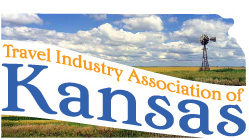 The Travel Industry Association of Kansas has issued a report that challenges the Governor to add biking trails to every scenic and historic byway, and each historic trail through the state, which could have an huge impact on Kansas tourism.
The Travel Industry Association of Kansas has issued a report that challenges the Governor to add biking trails to every scenic and historic byway, and each historic trail through the state, which could have an huge impact on Kansas tourism.
In December of 2011, the Travel Industry Association of Kansas issued a “Governor’s Challenge” report that highlighted five “product development opportunities upon which Kansas tourism professionals believe Kansas should focus”.
Of the five “solutions” presented in the report, two were directly focused on bicycling!
I think these are quite exciting and important proposals, so I’m going to reprint them in full.
Here’s the first:
PROJECT SOLUTION #1: OBTAIN DEDICATED RIGHT OF WAY AND CONSTRUCT HIKING/BIKING TRAILS ADJACENT TO EACH KANSAS BYWAY.
Background: The Kansas Byways are home to some of the great natural landscapes in the United States. They were formed to identify and designate scenic roadways for the enjoyment of the traveling public to Kansas. Currently, 10 byways serve to educate travelers about our nation’s environment and our state’s history and culture. They are aligned with the National Scenic Byways Program, a project of the 1991 Intermodal Surface Transportation Efficiency Act (ISTEA). Some of the nation’s most scenic experiences include: the largest interior marsh in the United States, significant wetlands for migrating birds, 100 foot bluffs, sandstone canyons, limestone quarries, diverse landscapes, glacial deposits, Native American and Western history, and natural beauty unique to Kansas.
Goal: Create a five-year plan to obtain right-of-way trails adjacent to each byway. Install the appropriate environmentally aligned surface to accommodate safe hiking/biking experiences. Obtain state support (legislative & departmental staff) to create the framework which will solidify public/private/federal partnerships ensuring all byways will be completed by the end of the five-year period (2012-2017).
Benefit: This project solution could place Kansas in the top five states in the nation for outdoor educational recreation. Such advancement would increase tourism, resulting in economic recovery to local communities along the byways as well as the entire state. Nationally, Kansas could become recognized as the healthy state, counter to obesity that is growing throughout the nation. Local communities would experience a renewed vitality as they each improve their product development along the byway. Such would enhance the current healthy partnership message the state is promoting with Blue Cross/Blue Shield. It would also strengthen the positioning of the state and national parks located within the designated byway area.
And the second:
PROJECT SOLUTION #4: OBTAIN DEDICATED RIGHT OF WAY AND CONSTRUCT HIKING/BIKING/RIDING TRAILS ADJACENT TO EACH OF THE FIVE MAJOR TRAILS IN KANSAS AND DEVELOP A PLAN TO INTERPRET THE HISTORY OF THE TRAILS.
Background: Several Native American Tribes ruled the western prairies and eastern woodlands that would later become the Sunflower State. As settlers moved westward, significant historical trails emerged that were instrumental in shaping the future of Kansas as well as for the entire nation. Whether by river, or by horseback, or by foot, or by rail, the westward movement of the nation’s settlers was significantly influenced by the land that would become Kansas. The state is fortunate to have had such a historical influence portrayed by the following trails:
- Lewis and Clark Trail
- Santa Fe Trail
- Oregon Trail
- Chisholm Trail
- Western Cattle Trail
Many of America’s most significant events and historical movements were impacted by Kansas and continue to be so today.
Goal: Create a ten-year plan to obtain right-of-way trails adjacent to each trail. Install the appropriate environmentally aligned surface to accommodate safe hiking/biking/horseback riding experiences. Obtain state support (legislative & departmental staff) to create the framework which will solidify public/private/federal partnerships ensuring all trails will be completed by the end of the ten-year period (2012-2022). In addition, work with appropriate historians to develop a plan to interpret the history and significance of the trails.
Benefit: Kansas could become a national leader in providing hiking/biking/horseback riding experiences adjacent to five major historical national trails. This development could provide stimulus to communities to improve travel/tourism product in their local communities for local, national and international travel. Such would provide the potential for economic recovery.
In addition an interpretative plan, which highlights the historical and significance importance of the trails, will enhance the trail experience and bring an educational component for the user.
I think we probably all agree that implementing these two ideas would have a tremendous impact on Kansas tourism.
I’ve provided Bicycling Guides for all these byways and historic trails, but this concept takes the idea to a completely different level.
Can you imagine? Being able to bike each scenic and historic byway, and each historic trail, on a dedicated off-road trail, free from traffic concerns … it’s an amazing concept.
It’s also difficult to envision actually happening, given Kansas’s historic reluctance to spend any state money on trail development, and the tremendous expense and political will necessary to complete these projects.
Still, if nothing else, these two ideas can hopefully spur state leaders, and ultimately voters, to move forward with trail development in the state of Kansas.
These are exciting ideas!
Bicycle Tourism is Big Business
In Kansas, tourism is already one of the top economic engines in the state, with a $5.83 billion economic impact, employing about 10% of the population, and provides nearly 15% of all state and local tax receipts. Each visitor to the state spent an average of $236 in 2011, and 73% of each tourism dollar spent in Kansas is retained in the state. (These numbers are from the Kansas Tourism 2011 report commissioned by the Kansas Department of Wildlife, Parks, and Tourism.)
The report does not break down the tourism contributions of different activities, such as bicycling, but many other states have done the research.
For instance, in Wisconsin, bicycling annually brings in $535 million in tourism from out of state visitors, and contributes $1.5 billion to the state’s economy each year.
In Iowa, bicycling generates $364.8 million in direct and indirect benefits to the state of Iowa every year.
An Oregon study found that “bicycle tourism injects a whopping $325 million into the Oregon economy” and “an overnight bike tourist had 19 times the economic impact of a day tourist.”
The League of American Bicyclists created this infographic that summarizes some of the impressive numbers from around the country.
We need to get Kansas on that map!




Randy,
I submitted plans in June 2012 to the State Scenic Byway Department in Topeka about a proposed recreational trail along the Prairie Trail Scenic Byway between Lindsborg and Marquette.
Best regards,
Fred Peterson, City Clerk
City of Marquette, Kansas (785-546-2205)
Awesome!